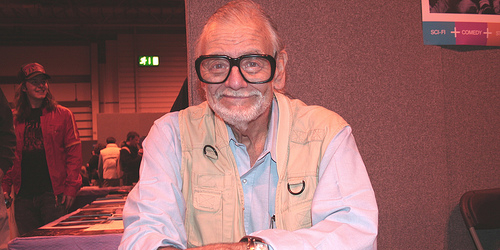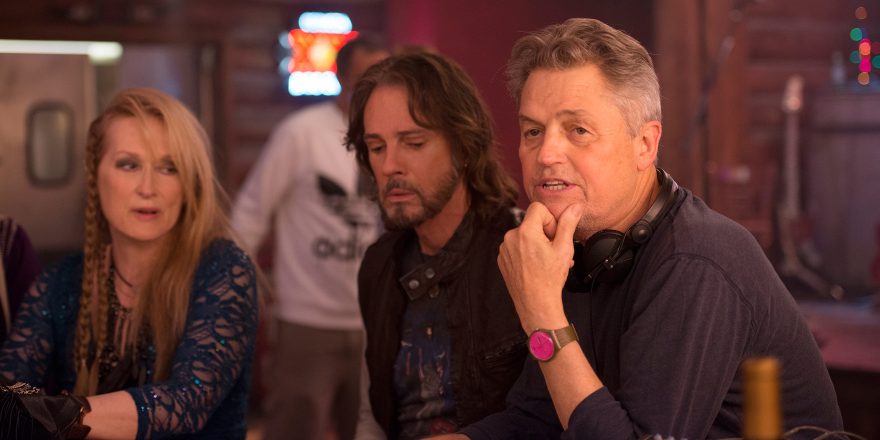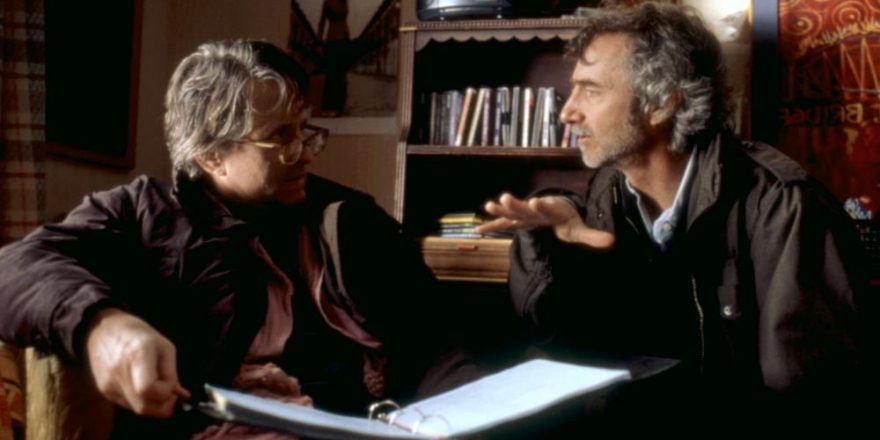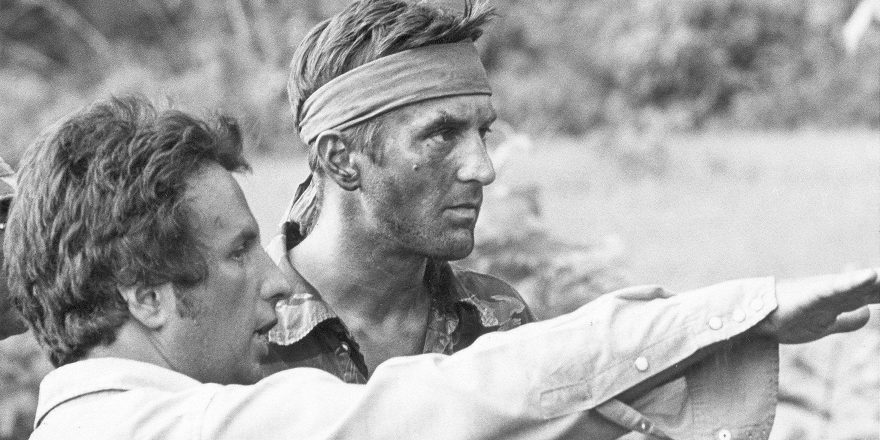In the following post, Talkhouse Film contributors and other filmmakers share their tributes to George A. Romero, the father of the zombie movie and the man behind such great movies as Night of the Living Dead, Martin and The Crazies, who passed away yesterday, aged 77.
More remembrances will be added to this post as they come in. Feel free to leave your own tributes and memories in the comments section. – N.D.
Lloyd Kaufman
I met George Romero when I was a nobody in the early ’70s and he was incredibly gracious. Over the years, we would see each other frequently at the various film festivals and conventions we would attend. If you watch any of the movies Michael Herz and I have made, you can see he had quite an influence on Troma. I’m still a nobody and he always remained very gracious. In my opinion, he changed the world, but if there are doubters of that, then he most certainly changed the world of cinema. The Troma Team and Toxie weep. RIP
Darren Lynn Bousman
The Saw films happened so fast. I literally went from being a broke 25-year-old couch-surfing ass clown, to suddenly directing these movies in Toronto.
I was terrified 24/7. What if they realize I am a fucking fraud?
That was my constant fear.
I grew up on horror. It was the one constant that never really changed from kid to adult.
It all started with one movie. Night of the Living Dead.
I think my parents let me watch this because at its surface it probably seemed harmless – I mean, it was black-and-white … If it’s black-and-white, it must be harmless…
I remember it so vividly. I was sitting in my grandparents’ house, my mouth hanging wide open at the shocking death of Duane Jones’s character Ben…
“Wait! WAIT! They can’t do that!!!” It was that death, that moment that opened my eyes to horror and what horror could do. What horror could make you feel.
Back to Saw II. Here I am in Toronto – no clue what the hell I am doing – and I am crewing up for department heads. What the fuck do I know about crewing anything? But luck was on my side: Land of the Dead had just finished shooting, and I noticed George Romero’s name on a bunch of resumes being sent to me. That was all I needed to hear … If they worked for Romero, then I had to have them on Saw. In retrospect, I probably pillaged his entire crew …
Because I surrounded myself with his department heads, I ended up getting invited to the Toronto friends and family screening of Land of the Dead. I am standing there, more nervous than I have ever been in my entire life, four feet from George Fucking Romero. The man who single handedly fucked my childhood (in the best way possible).
My body is literally trembling. This guy is a giant. Both in reputation and in stature.
Apprehensive, I inch over to him … “Mr. Romero, I just wanted to thank you.”
I explained that it was because of him and his first film that I am standing here now, about to direct my first feature.
The warmth that resonated off him was infectious.
He will be missed. But like the subject of his films, he will never really die …
Larry Fessenden
Over the years I have often cited George Romero’s Night of the Living Dead as my favorite horror movie. It served as a fulcrum between the old black-and-white horror films produced by Universal, featuring iconic monsters like Frankenstein and Dracula, and the more modern, despairing, angry and confrontational cinema of the ’60s and ’70s. I saw Living Dead on TV late one night and as a kid, I couldn’t tell when it had been made because it was still black-and-white, but I knew something was different. I knew the genre had grown up. Later, I was enamored with Martin, another film that grappled with the tension between movie monsters, in this case black-and-white vampire movies, and the very real, disturbing psychological violence of the young protagonist. And with The Crazies, Romero gave us a parable about mass hysteria and government overreach. Even when I could see the filmmaking was awkward and on the cheap, there was an energy and a fierce intelligence to Romero’s films, and their scrappiness felt like an invitation to aspiring filmmakers to just go out and do it. Of course he did make Creepshow, which had a budget and a cast and offered him the opportunity to celebrate his love of the DC comics that had influenced him as a kid. Romero was among a band of horror purveyors who came up in the ’60s and who ushered in a more brutal tone to the genre: Craven, Carpenter, Tobe Hooper — but distinct from his contemporaries, Romero seemed to resonate a conscience even as he relished in extreme gore. It is remarkable that a medium that is so collaborative still tends to convey the personality of the director, and in his films, you can feel George’s humility, thoughtfulness and sardonic anti-establishment sensibility. I often think about how Romero lamented he never really had a Hollywood career, never had it easy making films, no matter how influential and beloved he was. It has stood as a reminder that the embrace of Tinseltown is not the only measure of success in cinema.
Jeffrey Reddick
Few filmmakers have the ability to create a masterpiece right out of the gate, but among those people is George Romero. He will always be known for his first film, Night of the Living Dead. That film captured the essence of what would come to define most of Romero’s work. It tapped into the cultural zeitgeist and was about something. It exploited our fear of “the others” while showing us that “the others” are really us. The movie broke ground by featuring an African-American lead who survives the carnage, only to be killed by people who assume “he’s one of them.” It is a stark statement on the racial conflict at the time … that still strikes a chord today. But “the others” could stand in for any group, and that’s what makes this film timeless. His other work was also about something. Whether it was consumerism in Dawn of the Dead or the desire of the military to weaponize chemicals in The Crazies, Romero always had something to say with his work. And he said it with intelligence and humor.
This same intelligence and humor also made George Romero a wonderful person. In a town known for sharks, I’ve never met anyone who didn’t adore George. In addition to his many creative qualities, he was an extremely humble man. I don’t know if he ever fully grasped the impact he had on the film industry. And if he did, it never showed. But his mark on cinema will never be erased. His “light up a room” smile will never be forgotten. And whenever we see a movie with the dead walking the earth, we’ll think of him.
Gary Whitta
My parents, God bless them, never really curated or very much monitored what I watched when I was a kid, and the local video store didn’t care either, so I was able to rent and bring home a VHS copy of Dawn of the Dead when I was about 12 years old. I was never that interested in horror but something about the nightmare world Romero created enthralled me. I watched that movie so many times I came to know it practically frame by frame. The bad dreams began shortly after that, and I’m still visited by them to this day. As much as they haunt me, I’m grateful for them. For years, that sense of suffocating, omnipresent dread helped fuel my own imagination as a writer, fill out its darkest corners.
I never appreciated it when I was young, but as I grew older I came to understand that there was so much more going on with the Romero zombie films than just pure horror and gore. He found ways to employ a single conceit — the dead walking the earth, consuming the living — in service of so many thematic ideas. He tackled mindless consumerism, scientific ethics, unchecked militarism, class inequality, even the perils of social media. He never stopped finding new ways to make the undead speak to us.
Ten years ago I was lucky enough to meet George at a comic convention and thank him for all the nightmares. He will be sorely missed, but the films he gave us, like the shambling horrors that populated them, are forever undying.
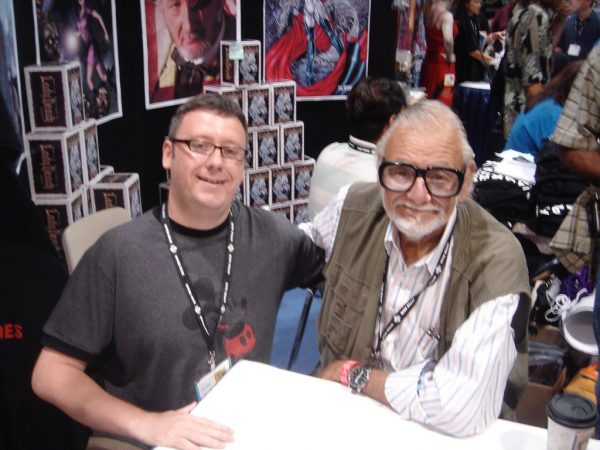
Brian Trenchard-Smith
1968’s Night of the Living Dead was initially banned in Australia, so my first exposure to the genius of George Romero was at the Egyptian Theater in Los Angeles the weekend Dawn of the Dead opened. OMG! Rivers of blood, graphic cannibalism, and social satire! I emerged gobsmacked, then joined the line for tickets to the next session. I had the honor to meet George Romero at the Melbourne Film Festival in 2008. What a charming, urbane, self-effacing man he was. Over canapes and goulash we discussed the mechanics of screen cannibalism. Several of the zombies in his Night of the Living Dead were investors, including a butcher who provided livers, kidneys, and intestines. Chunks of roast ham were the preferred diet for close-ups. At a time of generational change, George Romero pushed the boundaries of graphic bloodshed, infusing political comment along with deep suspicion of authority into his films. He influenced the next generation of filmmakers, and changed the horror genre forever. Vale, George. You will be missed.
Emily Hagins
I didn’t make a zombie movie as my first feature film just because I loved zombies – I was also heavily influenced by the work and perseverance of George A. Romero. He was one of the first directors I ever studied, and I was so inspired by his innovations and creativity within the genre while making the best of his budget and resources. Because of his films, I started to believe I could make my own independent horror movies as long as I had interesting characters to drive the story. Even though Creepshow has a completely different tone from Night of the Living Dead, they are united by compelling characters, twists on the horror genre, and social commentary that tell us, “Hey, horror movies can be fun and have something to say.” That’s what makes all of Mr. Romero’s films timeless to me. And on a personal note, I’ll never forget the few times we met and I shyly told him how much I looked up to him (and how kind and smart he was in return), or how shocked I was to hear that he knew about my little zombie movie.
Rodney Ascher
Growing up in the ’80s, it was still possible to hear about certain notorious films, (picking up details from unreliable older brothers of school friends or from still photos in old issues of Fangoria) without having any way to actually see them. Dawn of the Dead was one of those for me. I remember being told a story of a man trapped in an elevator facing monsters at every floor. I saw a black-and-white image of someone walking too close to a helicopter rotor. I knew the film had something to do with a shopping mall, which sounded crazy because horror movies take place in the woods or in old castles. I had to see it, but I couldn’t see it.
Life, uh, finds a way.
In my case, it was the AMC Midnight Movie Express. Multiplexes back then typically screened their final shows at 10 p.m., but one day some unsung hero at the AMC theater chain decided to give the Express a try. It was incredible while it lasted, entire suburban multiplexes screening the greatest hits (and some surprisingly deep cuts) at midnight all weekend long. Chainsaw to Phantom of the Paradise, Heavy Metal to Bloodsucking Freaks. Death Race 2000 to, Yes! Finally! one weekend, Dawn of the Dead. Midnight Movie Express was so special they even created this amazing trailer for it.
That was an incredible time for me and my friends and we had no idea how lucky we were to be in high school with lenient parents and brand new driver’s licenses during the brief window it lasted. Almost all the movies screened were fun in their way, some of them simply for the audacity with which they trampled over taboos, while others were genuinely inspired films that I still count as among my favorites. Dawn of the Dead is clearly in the latter category. I knew going in that it was going to be an incredibly gory zombie film, but what I didn’t know was that it was going to be a sometimes comic, sometimes tragic portrait of a country in perpetual civil war. I didn’t know that it would introduce me to four characters as real as friends or portray a newsroom in a state of chaos and panic as hilarious and horrifying as anything in Network (or happening live today).
I was just learning how much I could learn from these movies.
We’re still learning from them.
RIP George A. Romero
Calvin Lee Reeder
Night of the Living Dead is public domain. It used to be called Night of the Living Flesh Eaters but when the title card was changed the distributor forgot to copyright it. So Romero made no money. NO MONEY on fucking Night of the Living Dead. But other people made money, lots of other people. I guess some folks will read that and think the lesson is “Copyright and lawyer up.” That’s valid. But for me, it says the business is full of non-creative money vampires. They’re gonna find a way to suck your blood if you have a lawyer or not. And if the objective is to make money alone, then choose the path of the non-creative money vampire. They sleep ironically well.
But if you’re a creative person, you don’t have a choice. It’s a life sentence. George Romero served a beautiful life sentence and if you’re reading this, you don’t need me to tell you how important he is. He knuckled up, he pressed on, he fought the vampires with zombies and carved out a place in the movies that didn’t exist before. George Romero is resilience. If you make movies, you need that more than anything else. It’s a different world than the one Romero came up in, but you could say that about Jesus too. I’ve only read six pages of the Bible, but I’ve watched Romero my whole life. I still want to be just like him.
Clay Liford
If George Romero isn’t the biggest early influence on my filmmaking career, he’s certainly in the top 10. My little-seen first feature, A Four Course Meal, is a direct product of someone loving Creepshow way too much. Calling it an homage may be leaning on the charitable side. Romero invented the space in my brain for horror-comedy. To that point, he basically invented the space which accepts that horror films can talk about stuff other than jumps and screams, Dawn of the Dead being the first socially conscious horror film I ever saw. In fact, that movie means so much to me, it motivated the one and only “movie pilgrimage” I ever made. I was in Pittsburgh on a job, working 18-hour days. We had one day off, mostly to do laundry. But I saw the time as an excuse to visit the Monroeville Mall, clearly the most important mall in cinema history. It took me some spelunking, but I made off with a few pristine copies of the Monroeville Mall map. Some people look at my innocuous map and wonder why I have such an item on prominent display at my home. Others, the cool ones, totally get it.
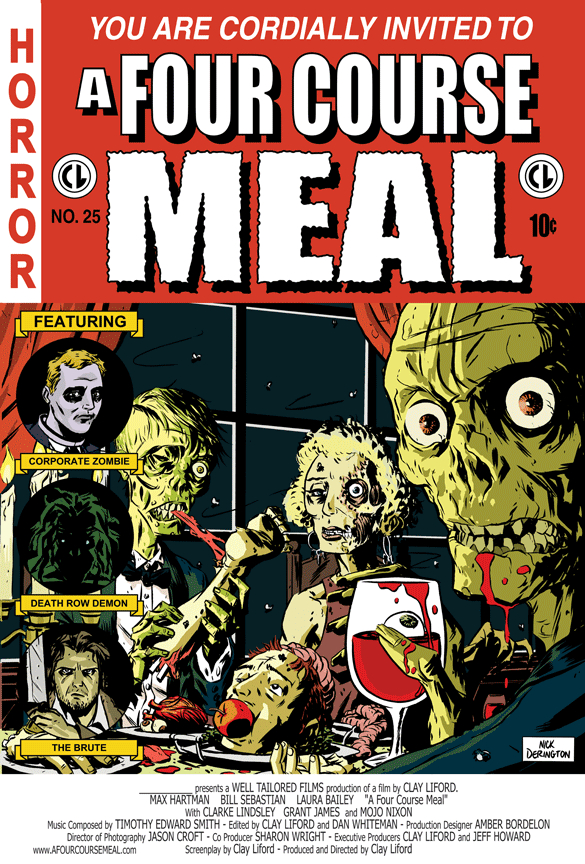
Nicholas McCarthy
I saw Night of the Living Dead for the first time, just after I had turned 11, at the Coolidge Corner Theater in suburban Boston. It was a few days before Christmas. My sister took me, and when we walked home it had started snowing. It was clear that I had seen something different from any other horror movie I’d encountered. In Night, everything extended from the characters, who were carefully drawn, and it felt like anyone might die at any time. The movie was humanist, but also pessimistic about humans. That’s George Romero in a nutshell, and no one made movies like him. His epic sequel Dawn of the Dead, produced only after he had pursued more personal and unusual projects, made me feel like I was watching a documentary of my world after it had been transformed by zombies. Romero and his Pittsburgh crew made the movie with breathless freedom inside that still-potent symbol of American consumerism, the shopping mall. As a teenager, this was a powerful piece of social commentary, and one of the reasons alongside Mad magazine and punk music I grew up skeptical about all things political or popular. But Dawn is ultimately a classic because, once again, dramatically the film is led by its characters. Every one of the living dead had some kind of character trait, and when one of the cast shoots them, Romero always includes a moment of our heroes registering disgust or despair at what they’ve done. Dawn is both anarchistic and humane.
Romero always remained interesting. I remember watching his downer third zombie film Day of the Dead at one of Boston’s last grindhouse theaters, while a young couple accompanied by their newborn smoked dope in the front row. Presumed at the time to be the final entry in Romero’s zombie world, in this chapter military assholes have taken over what’s left of humanity while we, the audience, wait for the walls to close in. In the 1980s, it wasn’t hard to figure out how this would foretell the future. And Romero could do that because the people in his movies were us, and the films took place in our world, so they had an intuitive truth to them that other movies didn’t. Like the walls that always fell at the end of his zombie films, his best work was always about stripping away the sentimental and forcing us to look at things for how they really were. We have a lot still to learn from him, and he will be missed.
Zach Clark
America has always been eating itself. George Romero knew it. Dawn of the Dead is his masterpiece— equal parts grand scale horror, political satire, and social anthropology — but the achingly humane and heartbreaking Martin will forever be my favorite.



